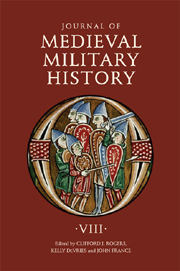Book contents
- Frontmatter
- Contents
- 1 People against Mercenaries: The Capuchins in Southern Gaul
- 2 The Last Italian Expedition of Henry IV: Re-reading the Vita Mathildis of Donizone of Canossa
- 3 Jaime I of Aragon: Child and Master of the Spanish Reconquest
- 4 Numbers in Mongol Warfare
- 5 Battlefield Medicine in Wolfram's Parzival
- 6 Battle-Seeking, Battle-Avoiding or perhaps just Battle-Willing? Applying the Gillingham Paradigm to Enrique II of Castile
- 7 Outrance and Plaisance
- 8 Guns and Goddams: Was there a Military Revolution in Lancastrian Normandy 1415–50?
- The Name of the Siege Engine trebuchet: Etymology and History in Medieval France and Britain
- Journal of Medieval Military History 1477–545
1 - People against Mercenaries: The Capuchins in Southern Gaul
Published online by Cambridge University Press: 12 September 2012
- Frontmatter
- Contents
- 1 People against Mercenaries: The Capuchins in Southern Gaul
- 2 The Last Italian Expedition of Henry IV: Re-reading the Vita Mathildis of Donizone of Canossa
- 3 Jaime I of Aragon: Child and Master of the Spanish Reconquest
- 4 Numbers in Mongol Warfare
- 5 Battlefield Medicine in Wolfram's Parzival
- 6 Battle-Seeking, Battle-Avoiding or perhaps just Battle-Willing? Applying the Gillingham Paradigm to Enrique II of Castile
- 7 Outrance and Plaisance
- 8 Guns and Goddams: Was there a Military Revolution in Lancastrian Normandy 1415–50?
- The Name of the Siege Engine trebuchet: Etymology and History in Medieval France and Britain
- Journal of Medieval Military History 1477–545
Summary
The Capuchins were a sworn confraternity whose members took up arms in order to impose the peace in the violently disordered world of southern Gaul in the years 1182–84. In doing this they acted under the authority of Canon 27 of the Third Lateran Council of 1179, and took upon themselves something of the character of crusaders. Their movement originated amongst the townspeople of Le Puy in the Auvergne, and although it embraced all classes of society and enjoyed the approbation of bishops and clergy, it was clearly popular rather than aristocratic in nature. For a time it was remarkably successful. Ultimately the Capuchins found themselves confronting the great powers of the area and were crushed by troops in the service of the great men whose quarrels were the ultimate cause of the political disorder which plagued southern Gaul. The circumstances both of their success and their failure tell us something of military reality in twelfth-century Europe.
Our vision of medieval warfare in the twelfth century is dominated by the upper classes. The men on horseback, knights and great lords, claimed to be the rightful arms-bearers and protectors of society. They portray themselves on seals and in pictures, mounted, in full armor, often bearing swords, because the military role was central to their sense of identity. They even adapted their religious beliefs to suit their way of life. Most of the chroniclers of the age, when they talk about war, focus on their deeds as warriors. And they certainly were the leading element in all the armies of the period.
- Type
- Chapter
- Information
- Journal of Medieval Military History , pp. 1 - 22Publisher: Boydell & BrewerPrint publication year: 2010

